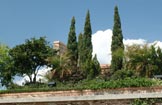Green Roofs for Urban Areas
Growing Better Buildings
As urban populations grow, the dilemma of how to create and sustain a healthy urban ecosystem is becoming more prominent. The urban heat island effect, stormwater runoff, air pollution, and the loss of tree canopy, green space, and wildlife habitat are all issues affecting urban sustainability. Green roofs, which are specially designed landscapes atop buildings, can provide solutions to many of these problems, as well as enhance the quality of life for urban residents.
Introduction
Sod roofs and walls have been used as construction materials in Northern Europe for hundreds of years. The development of contemporary approaches to green roof technology began in urban areas of Germany over thirty years ago. In the United States, many green roofs are now in place, including on Chicago’s city hall, University of Florida’s Perry Construction Yard building, and Ford’s truck assembly plant in Michigan. City governments, large corporations, and other entities with significant financial resources are sponsoring green roof programs and leading the way in promoting the adoption of green roof technologies.
Benefits
Green roofs can provide numerous benefits for communities and building occupants, including:
- Runoff reduction. Reduction of the quantity and pollutant levels of stormwater runoff, decreasing the need to expand community water treatment infrastructure
- Pollution mitigation. Filtration of chemical air pollutants and the physical capture of airborne particulates
- Heat reduction. Decrease of urban heat island effects
- Habitat creation. Addition of habitat for wildlife
- Energy conservation. Increase of thermal insulation of buildings, which reduces heating and cooling use
- Cost savings. Reduction of costs of roofing maintenance and replacement and building energy costs
- Better work environment. Improved air quality, and rewards gained from viewing or caring for plants
- More room. Increase of usable space for meetings, recreational activities, and community events
- Farming area. Expansion of opportunities for urban agriculture and community food security
Types of Green Roofs
All well-designed green roofs include subsystems for drainage, plant nourishment and support, and protection of underlying waterproofing systems. Green roofs must both maintain growing conditions and manage heavy rainfall, without sustaining damage from erosion or pooling of water.
The engineered roof “soil” must meet specific requirements for numerous parameters, including grain-size, air spaces, and moisture retention. Plants selected for green roofs are determined by site-specific "right plant-right place" requirements.
There are two main types of green roofs: intensive and extensive. The roof type used depends on the structural capacity of the building and on the project goals.
Intensive Roofs
Intensive green roofs are traditional-style roof gardens that allow a greater variety of vegetation, including trees and shrubs. They often are accessible to the public and can include garden paths, seating, and other features that make the roof an outdoor room. Since they are meant to be similar to a park, they generally are on flat roofs.
As suggested by the name, they are labor-intensive, requiring irrigation and continuous maintenance. Intensive roofs are multi-layer constructions, typically installed over concrete roof decks, with substantial structural capacity and weight loads.
Extensive Roofs
Extensive roofs are not designed for public use but are more for environmental benefits. They help to mitigate the effects of urbanization on water quality by filtering, absorbing, or detaining rainfall. These roofs consist of a lightweight soil medium overlying a drainage layer and high quality impermeable membrane that protects the building structure.
Roof vegetation consists of plants that can thrive in the harsh, dry, high temperature conditions of the roof and tolerate short periods of inundation from storm events. Wildflowers, grasses, and especially sedums are common selections. Sod usually is not used for extensive roof applications because it is maintenance-intensive. Extensive green roofs require only periodic maintenance for weeding and watering (if natural rainfall is not sufficient).
Extensive roofs are suitable for sloped roofs, which can be angled up to forty-five degrees if a raised grid structure is used to stabilize the growing medium until plants form a thick vegetation mat. A flat roof requires an additional layer to drain excess water away from the root zone.
Financial Considerations
The initial cost of a green roof can be higher than that of a traditional roof. While green roof construction is similar to construction for a conventional gravel-ballasted roof, the soil substrate and plants are additional expenses.
Currently, funding for green roofs is available through the U.S. Environmental Protection Agency's Clean Water Act Section 319 (non-point source pollution) grant program and through local environmental funding initiatives.
The growing adoption of green roofs presents unique business opportunities. Landscape and nursery professionals can create a specialty niche that caters to the green building community. Beyond commercial accounts, green roofs have vast growth potential in residential landscape sectors. Additionally, jobs and revenue may be produced by suppliers and manufacturers of specialized roofing materials and services.
Potential benefits for developers include: increased property values; increased market exposure; reduced stormwater/wastewater charges; reduction in the size of stormwater management facilities; grants related to energy efficiency or green roofs; satisfaction of minimum parkland requirements; and greenhouse gas emissions trading credits from energy savings.
The significant environmental benefits of green roofs may be difficult to calculate. However, such benefits—combined with improved roof longevity and thermal insulation capacity—can outweigh the increased installation costs for most green roof projects.
Adapted from:
E. Worden, et al, Green Roofs in Urban Landscapes (ENH 984), Environmental Horticulture Department (9/2004).
B.J. Jarvis, “Rainwater Harvesting: More than just rainbarrels” (2.21MB pdf), Pasco County Extension (10/2008).
“Great Lakes WATER Institute Green Roof Project: Green Roof Installation,” University of Wisconsin—Milwaukee Great Lakes WATER Institute (retrieved 2/2011).

Related Sites & Articles
- UF/IFAS Publications
- Green Roofs/Eco-roofs (1.18MB pdf)
- Enviroscaping
- Low Impact Development Fact Sheets
- Other Sites & Publications
- Green Roof Benefits—ISU Extension
- Green Roofs are Starting to Sprout in American Cities—Yale Environment 360
- Green Building Funding Opportunities—U.S. EPA
- Heat Island Effects & Green Roofs—U.S. EPA
- Stormwater & Green Roofs—U.S. EPA
- Green Infrastructure—U.S. EPA

